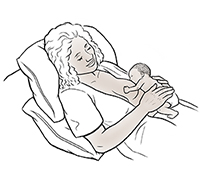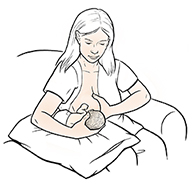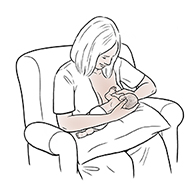Breastfeeding Your Infant in the NICU
For a time, your baby will be cared for in the NICU (neonatal intensive care unit). This is a stressful experience for birth parents. They are often concerned that they will not be able to breastfeed. If your baby is in the NICU, your milk is the best food for your baby. Think of your milk as an actual medicine that no one else can make. It's specifically tailored to the needs of your preemie. Your milk contains immune factors that help your baby fight off infection. It also protects your baby's bowels from damage and helps them develop and grow.
At first, your baby might not be able to feed directly from your breast. As your baby is able, you will be able to practice breastfeeding together. This can help you bond with your baby and be more involved in your baby's care.
At first, you may not be able to supply all of your baby's food. It can take time to build up a milk supply. Donor milk from a milk bank may be available in this case. And because very premature infants need more protein and calcium, your milk may be fortified or supplemented. Your baby's healthcare provider will discuss this with you. Remember that any amount of milk that you provide for your baby is important. Even if your baby was born too early or is too ill to have large amounts, milk can be used to swab the inside of their mouth. Swabbing the inside of your baby’s mouth helps them to have some of the immune protection of your breastmilk. Your milk can also be saved for future use. Your baby's healthcare team will also want to know about any medicines that you are using as you bring your milk to the NICU.
How do I start and maintain my milk supply?
Normally, breastfeeding stimulates your body to make more milk. If your baby can't nurse, it’s important to express or pump milk as frequently as a full-term baby would nurse. This helps you develop a full milk supply. Your baby may not yet be ready to accept all of this milk. So the milk you collect will be stored for future use if it's over what your baby is able to take. The best time to start pumping or expressing is within 6 hours after your delivery; the sooner the better. If you delay milk expression, don't express milk often, or only pump what your baby is actually taking, you may not make enough milk to feed your baby. Using a hands-on pumping method helps you make more milk. So does spending time skin-to-skin with your baby. While expressing milk takes work and commitment, most breastfeeding parents find the process of providing for their sick or premature infant to be a rewarding experience.
Guidelines for pumping
-
Start within the first 6 hours after birth, if possible. Use a hands-on method.
-
Your healthcare team may teach you to express milk using just your hands during those early days. For the first couple of days after your delivery, this can help you express colostrum for your NICU baby.
-
Hand-expressing milk can work well. But an electric pump also helps. Pump at least 8 to 10 times each 24-hour period. Try not to let your breasts stay full, because that will decrease how much milk you make. Each person stores a different amount of milk in their breasts. So the time between pumping sessions may be different for different people. You can find a routine that works best for you.
-
Empty the breasts with each pumping. Every person is different. So this may take more or less time for you than for someone else. Gentle massage can help with emptying. Pump until the milk stops coming out or for about 20 minutes.
-
Try not to go more than 3 hours without pumping at first. Some people are able to space slightly longer once in 24 hours once their supply is well-established. It may also be advised that you do this if you are struggling from a postpartum mood disorder.
-
Wash your hands well with soap and clean, running water before handling the pump or collection kit.
-
Be sure to get enough rest and fluids by drinking as soon as you are thirsty. This will help maintain your milk supply.
-
If possible, use an electric pump. This kind of pump is important for keeping up milk supply for breastfeeding parents and babies who are separated. These pumps cost much more than the more commonly used personal pumps. You can rent a pump to use at home. Your baby's healthcare team can give you a prescription for insurance to cover the cost of the rental, if needed.
-
To pump from both breasts at the same time (double pump), use a double milk-collection kit that attaches to the breast pump. Double pumping increases prolactin. This is the hormone that stimulates your breasts to make milk. Double pumping also saves you time.
-
Massage the breasts gently before pumping and during pumping. This helps stimulate let-down of the milk. Massaging while you pump helps express more milk with higher fat content.
-
Start with a low pump pressure setting. Increase it as you get used to the feel of pumping. Use the highest comfortable setting that you can. The nurse can show you how the pump in the hospital works. For pumping at home, be sure to read the pump maker's directions on how to use the pump.
-
If pumping hurts your nipple at any time, ask to see a lactation consultant. They can help you find the right fit of the pump flange.
Important: After pumping be sure to follow the pump maker's directions for cleaning the pump collection kit after each pumping. This can help prevent your baby from getting an infection.
Storing your milk
It’s best to give your baby milk that has just been expressed. If you will not be with your baby right away after pumping, you will have to store your milk to use later. In general, follow these guidelines to store milk:
-
Use very clean or sterile containers. A NICU nurse can give you these or tell you where to get them. It is best to use hard plastic or glass containers, not plastic bags.
-
Label each bottle as told to by the nurse. Unless told otherwise, you should write the baby’s name, the date and time the milk was pumped, and whether the milk was fresh or frozen. Your baby's healthcare team will want to know which medicines you are taking.
-
Don’t mix milk from different pumping sessions.
-
Keep storage times in mind. Hospitals may have their own process for storing milk for infants in the hospital. In general, the following may be typical storage times advised for NICU babies. These times may differ from hospital to hospital. Longer storage times can be used for babies who are not in the NICU.
|
|
Storage location and temperature
|
|
Type of breastmilk
|
Countertop: room temperature
|
Refrigerator: 40°F (4°C)
|
Freezer: 0°F (-18°C)
|
|
Freshly expressed or pumped
|
Up to 4 hours
|
Up to 4 days
|
Within 6 months is best; up to 12 months is acceptable
|
|
Thawed, previously frozen
|
1 to 2 hours
|
Up to 1 day (24 hours)
|
Never refreeze breastmilk after it has been thawed
|
|
Leftover from a feeding
|
Use within 2 hours after baby is finished feeding
|
Source: CDC
Getting started with breastfeeding
Before your baby is ready to breastfeed in the NICU, you may start with practice (non-nutritive) breastfeeding. This means putting the baby to the breast to suckle, without expecting the baby to feed. It will help with your baby's digestion. The nurse will help you put your baby skin-to-skin. This means your baby's bare chest on your bare chest. Skin-to-skin can also help you and your baby bond. When babies are placed skin-to-skin, they have perfect temperature control, a steadier heart rate, more even breathing and less stress. Skin-to-skin may help prevent or overcome oral aversion in babies. This means a dislike of having things put in the mouth. Some babies in the NICU develop an oral aversion because of having tubes in their mouth for food or air.
Your baby will start out with licking and tasting. But over time they will begin to latch on and eventually start to take in some milk. This amount will increase as your baby grows stronger. Once the baby is latching onto the breast, you may use a nipple shield made of very thin silicone to help them stay latched until the baby becomes stronger. As the time your baby spends suckling increases, the NICU staff may teach you to do test weights. That is weighing your baby before and after a feeding to see how much milk the baby is taking in.
Learning to feed is a very gradual process. It’s like learning to walk. It normally takes weeks for a premature baby to go through this process. This is true whether the baby is learning to feed at the breast or from a bottle.
Tips for holding your baby while breastfeeding
-
Make sure you are comfortable first.
-
For good support, hold the baby’s head with your fingers behind his ears. Support the baby’s body with your wrist and arm.
-
Keep the baby’s body in a straight line with the head and neck. The baby's body should be in contact with your own from chest to tummy.
-
Sit in a comfortable position, so that you’re not leaning forward over the baby. Try this: Sit on the edge of the chair and lay back into the chair. Place your baby on your chest and give them a chance to wiggle over to your nipple. Bring the baby to the breast, not the breast to the baby.
-
Use pillows or other props to help support your back and arms while you hold your baby.
Breastfeeding positions
Preemies need to feed in positions that give extra support for their neck and head. The following are the safest positions for nursing preemies.
"Laid-back" position
Lie back in a chair, with your body on a 45-degree angle. In this position, your chest is a good place for your baby to move around on their tummy. Your baby's whole body is supported. They can use reflexes to move toward your nipple, find the nipple, and start to nurse. This will be the most comfortable position for both of you. You will have a hand free because your body is holding the baby.

Football hold
Place a pillow at your side next to the breast you’re going to use. Lay your baby on the pillow at breast height so that your baby’s bottom is lower than their head. Hold your baby's head with your fingers behind the ears at the neck. Use your forearm to support the shoulders and spine. Your baby's body should be facing your body so that you can tuck the baby’s legs between your arm and body. Your other hand is used to support your breast. If you’re nursing twins, you may eventually be able to use this hold to nurse both babies at once. But each baby will need focused individual attention during feedings at first.

Cross-cradle hold or "opposite hand" hold
Put a pillow in your lap and lay your baby across your lap at breast height. Make sure your baby's bottom is lower than the head on the pillow and that their body is facing and touching your body. Support the baby’s head and neck with the hand and arm opposite the breast you’re using. Hold your baby’s head just below the ears, at the nape of the neck. Your other hand will support your breast.
